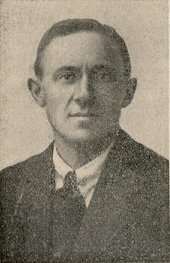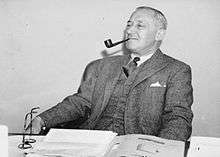Manny Shinwell
| The Right Honourable The Lord Shinwell CH PC | |
|---|---|
 Shinwell in 1920 | |
| Minister for Defence | |
|
In office 28 February 1950 – 26 October 1951 | |
| Prime Minister | Clement Attlee |
| Preceded by | A. V. Alexander |
| Succeeded by | Winston Churchill |
| Secretary of State for War | |
|
In office 7 October 1947 – 28 February 1950 | |
| Prime Minister | Clement Attlee |
| Preceded by | Frederick Bellenger |
| Succeeded by | John Strachey |
| Personal details | |
| Born |
Emanuel Shinwell 18 October 1884 Spitalfields, London, England, UK |
| Died | 8 May 1986 (aged 101) |
| Nationality | United Kingdom |
| Political party | Labour |
Emanuel Shinwell, Baron Shinwell CH PC (18 October 1884 – 8 May 1986), known informally as Manny Shinwell, was a British trade union official, Labour politician and one of the leading figures of Red Clydeside. He is best remembered for being in charge of Britain's coal supply during the extremely harsh winter of January to March 1947. Coal had just been nationalized and the supply system collapsed, leaving Britain to freeze and close down. Shinwell denied there were problems and refused to assume responsibility, blaming the climate, the railway system, or capitalism generally. The cabinet had to take control away from him and he became the scapegoat.[1]
Early life, career and trade union activities
Shinwell was born in Spitalfields, London, but his family moved to Glasgow, Scotland. His father was a Polish Jew who had a small clothing shop and his mother, a Dutch Jew, was a cook from London.[2] He educated himself in a public library and at the Kelvingrove Art Gallery. He enjoyed sport, particularly boxing, and he was the trainer of a local football team. He began his working life as a machinist in a clothing workshop. In 1903 he became active in the Amalgamated Union of Clothing Operatives, and joined the Glasgow Trades Council in 1906 as a delegate of that union.
In May 1911, he was seconded to help organise the seamen of Glasgow at the request of Havelock Wilson of the National Sailors' and Firemen's Union (NSFU). He played a prominent role in the six-week Glasgow seamen's strike which began on 14 June and which was part of a nationwide strike. He subsequently became the secretary of the Glasgow branch of the NSFU. In August 1912, he participated in a revolt against the union, which resulted in the Glasgow branch becoming part of the Southampton-based British Seafarers' Union (BSU). He was the local secretary of the BSU until it became part of the Amalgamated Marine Workers' Union (AMWU) in 1922, after which he served as National Organiser of the new organisation. In 1919, he gained national notoriety through his involvement in the Glasgow 40 Hours' Movement. This movement culminated in clashes between police and protesters in Glasgow's George Square. He was afterwards tried for incitement to riot and was sentenced to five months' imprisonment. [3]
Political career

An Independent Labour Party (ILP) member, he was elected as Member of Parliament (MP) for Linlithgowshire at the 1922 general election. He lost his seat in 1924, but was re-elected for Linlithgowshire at a by-election in 1928. In 1929 Ramsay MacDonald appointed him Financial Secretary to the War Office: Cowling says that MacDonald believed he had rescued Shinwell's ministerial career when no minister would take him. From 1930 Shinwell served as Secretary for Mines, an office he had previously held in 1924. He became a critic of Ramsay MacDonald's National Government, and in 1931 he again lost his seat.
He returned to the Commons in 1935 for Seaham, County Durham, after defeating MacDonald, whereafter he campaigned vigorously, along with left-wingers such as Aneurin Bevan, for Britain to support the Popular Front government in Spain against Franco in the Spanish Civil War. On 4 April 1938, during a heated House of Commons debate in which he had been criticising the government's foreign policy, he slapped the face of the Conservative MP Commander Robert Tatton Bower after Bower told him to "go back to Poland".[4] Shinwell said he had taken this to be an anti-semitic remark.[5] In May 1940 he refused a position in Winston Churchill's Coalition Government in the Ministry of Food. He became chairman of the Labour Party in 1942. He served in Clement Attlee's government after the Labour victory in 1945 as Minister of Fuel & Power, and he presided over the nationalisation of the mining industry. His insistence on the open cast mining of the park of the Wentworth Woodhouse estate, to the footsteps of the house, when the quality of the coal was poor, was viewed by its owners and the local mining community which opposed it as pure vindictiveness - an act of class warfare.[6]

In 1947, Britain experienced, in an exceptionally severe winter, a serious coal shortage. He was widely criticised for his failure to avert this crisis. Shortly afterwards he was sacked, his job given to his former deputy Hugh Gaitskell, and was demoted to Secretary of State for War (Minister for the Army, but no longer a full member of the Cabinet) which he held until 1950. In November 1947 an MI5 report alleged that Shinwell had passed secret information to a man named "Stanley" who had passed it on to Zionist paramilitary group Irgun. Shinwell knew self-styled "contact man" Sidney Stanley whom he had approached for help in finding employment for his son Ernie, and Stanley had obtained information on the disbandment of the Transjordan Frontier Force from some government source.[7]
His seat became Easington at the February 1950 election, after which he was promoted to Minister of Defence and became a full member of the Cabinet once more. Edmund Dell describes him as “putty in the hands of the defence chiefs” and his promotion as "[a] ludicrous appointment. No failure was ever great enough to persuade Attlee to deny one of his cohorts new opportunities to do damage … Shinwell never forgave Gaitskell whom he blamed for his disgrace." Gaitskell, promoted to Chancellor of the Exchequer later in the year, recorded in his diary that Shinwell "never loses an opportunity of picking a quarrel with me, sometimes on the most ridiculous grounds”. Against the backdrop of the Korean War which had begun in June 1950, Shinwell was responsible for the rearmament programme which precipitated the resignation of Aneurin Bevan from the Cabinet in the spring of 1951, although Gaitskell actually gave him less defence spending than he wanted.[8] At the Labour Party Conference that autumn Shinwell lost his seat as an elected constituency representative on the Labour Party National Executive Committee (NEC), the members of which were increasingly elected by Bevanites in the constituency parties. Labour lost the general election a month later.[9]
Towards the end of his Commons career, he served as Chairman of the Parliamentary Labour Party, 1964-67. Shinwell was appointed to the Order of the Companions of Honour in the 1965 Birthday Honours[10] and was created a life peer as Baron Shinwell, of Easington in the County of Durham, on 19 June 1970.[11] He continued to be active in the House of Lords until shortly before his death.[12]
Shinwell died in May 1986, aged 101, holding the record for the second longest-lived British MP (after Theodore Cooke Taylor) until overtaken by Bert Hazell in November 2008. He became the longest lived peer on 26 March 1986, dying little over a month later on 8 May.
Shinwell sat for sculptor Alan Thornhill for a portrait[13] in clay.
The correspondence file relating to the Shinwell portrait bust is held as part of the Thornhill Papers (2006:56) in the archive[14] of the Henry Moore Foundation's Henry Moore Institute in Leeds and the terracotta remains in the collection of the artist. A bronze (accession number S.309) was purchased into the Collection of Glasgow City Art Gallery in 1973.[15]
Shinwell's great niece is the Labour MP for Liverpool Wavertree, Luciana Berger.
References
- ↑ Kenneth O. Morgan, The people's peace: British history, 1945-1990 (1992) pp 68-69.
- ↑ Samuelson, Maurice. "Lord Shinwell Dead at 101". jta.org. Retrieved 22 March 2013.
- ↑ "Diagram of George Square used by defence lawyers in trial of Emanuel Shinwell". sites.scran.ac.uk. Retrieved 2016-01-30.
- ↑
- ↑
- ↑ Bailey, Catherine (2007). Black Diamonds: The Rise and Fall of an English Dynasty. London: Penguin. pp. 385–393. ISBN 0670915424.
- ↑ Andrew, C. (2009). The Defence of the Realm: The Authorized History of MI5. London, UK: Allen Lane. pp. 360–362. ISBN 978-0-141-02330-4.
- ↑ Dell 1997, p.145, 153
- ↑ Campbell 1987, p.256
- ↑ The London Gazette: (Supplement) no. 43667. p. 5496. 4 June 1965.
- ↑ The London Gazette: no. 45137. p. 7103. 26 June 1970.
- ↑ Hansard 1803–2005: contributions in Parliament by Lord Shinwell
- ↑ portrait head of Lord Shinwell image of sculpture
- ↑ HMI Archive; accessed 13 May 2014.
- ↑ Kelvingrove Art Gallery and Museum; accessed 13 May 2014.
Bibliography
Shinwell wrote three volumes of autobiography:
- Conflict Without Malice (1955)
- I've Lived Through it All (1973)
- Lead With the Left (1981)
Shinwell wrote "When The Men Come Home" (1944)
Biography:
- Slowe, Peter, "Manny Shinwell" Pluto Press (1993), foreword by Harold Wilson. ISBN 9780745307374
Scholarly studies:
- Robertson Alex J.. The Bleak Midwinter 1947 (Manchester University Press. 1987). Pp. x, 207
Book used for citations:
- Campbell, John (1987). Nye Bevan and the Mirage of British Socialism. London: Weidenfeld & Nicolson. ISBN 978-0-297-78998-7.
- Dell, Edmund (1997). The Chancellors: A History of the Chancellors of the Exchequer, 1945-90. London: HarperCollins. ISBN 978-0-006-38418-2.
Archives
External links
- Hansard 1803–2005: contributions in Parliament by Lord Shinwell
.svg.png)